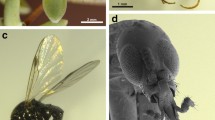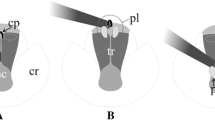Abstract
Several studies have recently shown that floral scent can deter ants from flowers. However, when ants serve as reliable pollen vectors, for example in harsh, windy habitats, were flying insects are less active, plants should have evolved floral signals to attract them to the flowers. We tested this hypothesis in the alpine orchid, Chamorchis alpina. C. alpina was found to be predominantly ant pollinated, with some occasional pollination by ichneumonid wasps. In all three investigated populations, only two species of ants, Formica lemani and Leptothorax acervorum visited the flowers and removed pollinaria. These two pollinator ants were found to be among the most common ant species in all habitats, but other, non-pollinating ants were also frequently found, suggesting a factor that mediates specific pollination. Floral morphology was found to be compatible with at least one of the common non-pollinator ants. Floral scent consistently comprised five terpenoid compounds, β-phellandrene, 1,8-cineole, linalool, α-terpineol, and β-caryophyllene. A synthetic blend of these five compounds emitting from rubber septa, was found to be attractive to one pollinator ant-species, F. lemani, in the field. The floral scent of C. alpina, through attracting only specific ants, may thus play a role in filtering floral visitors.



Similar content being viewed by others
References
Baumann B, Baumann H (2010) Pollination of Chamorchis alpina (L.) Rich. in the alps by worker ants of Formica lemani Bondroit: first record of ant pollination in Europe. J Eur Orch 42:3–20
Beattie AJ (2007) The evolution of ant pollination systems. Bot Jahrb Syst 127:43–55
Beattie AJ, Turnbull C, Knox RB, Williams EG (1984) Ant inhibition of pollen function—a possible reason why ant pollination is rare. Am J Bot 71:421–426
Cosacov A, Nattero J, Cocucci AA (2008) Variation of pollinator assemblages and pollen limitation in a locally specialized system: the oil-producing Nierembergia linariifolia (Solanaceae). Ann Bot 102:723–734
Dietrich CO, Ölzant S (1998) Formicidae (Hymenoptera) der Illmündung (Österreich: Vorarlberg) mit einem Beitrag zur Barberfallenmethodik bei Ameisen. Myrmecologische Nachrichten 2:7–13
Faegri K, van der Pijl L (1979) The principles of pollination ecology. Pergamon Press, Oxford
Fenster CB, Armbruster WS, Wilson P, Dudash MR, Thomson JD (2004) Pollination syndromes and floral specialization. Annu Rev Ecol Evol Syst 35:375–403
Gomez JM, Zamora R (1999) Generalization vs. specialization in the pollination system of Hormathophylla spinosa (Cruciferae). Ecology 80:796–805
Grant V, Grant KA (1965) Flower pollination in the Phlox family. Columbia University Press, New York
Herrera CM, Castellanos MC, Medrano M (2006) Geographical context of floral evolution: towards an improved research programme in floral diversification. In: Harder LD, Barrett SCH (eds) Ecology and evolution of flowers. Oxford University Press, Oxford, pp 278–294
Hölldobler B, Wilson EO (1990) The ants. The Belknap Press of Harvard University Press, Cambridge
Johnson SD, Hargreaves AL, Brown M (2006) Dark, bitter-tasting nectar functions as a filter of flower visitors in a gbird-pollinated plant. Ecology 87:2709–2716
Johnson SD, Steiner KE (2000) Generalization versus specialization in plant pollination systems. Tree 15:140–143
Junker RR, Bluthgen N (2008) Floral scents repel potentially nectar-thieving ants. Evol Ecol Res 10:295–308
Junker RJ, Blüthgen N (2010) Floral scents repel facultative flower visitors, but attract obligate ones. Ann Bot 105:777–782
Kay KM, Sargent RD (2009) The role of animal pollination in plant speciation: integrating ecology, geography, and genetics. Annu Rev Ecol Evol Syst 40:637–656
Kutter H (1977) Hymenoptera Formicidae. Fauna Insecta Helvetica 6, Zürich, 293 pp
Melendez-Ackerman E, Campbell DR, Waser NM (1997) Hummingbird behavior and mechanisms of selection on flower color in Ipomopsis. Ecology 78:2532–2541
Müller H (1881) Alpenblumen, ihre Befruchtung durch Insekten und ihre Anpassungen an dieselben. Verlag von Wilhelm Engelmann, Leipzig
Nilsson A (1981) The pollination ecology of Listera ovata (Orchidaceae). Nordic J Bot 1:461–480
Nilsson LA (1988) The evolution of flowers with deep corolla tubes. Nature 334:147–149
Peakall R (1989) The unique pollination of Leporella fimbriata (Orchidaceae)—pollination by pseudocopulating male ants (Myrmecia urens, Formicidae). Plant Syst Evol 167:137–148
Peakall R, Angus CJ, Beattie AJ (1990) The significance of ant and plant traits for ant pollination in Leporella fimbriata. Oecologia 84:457–460
Peakall R, Beattie AJ (1989) Pollination of the orchid Microtis parviflora R BR by flightless worker ants. Funct Ecol 3:515–522
Peakall R, Beattie AJ (1991) The genetic consequences of worker ant pollination in a self-compatible clonal orchid. Evolution 45:1837–1848
Peakall R, Handel SN, Beattie AJ (1991) The evidence for, and importance of, ant pollination. Ant Plant Interact 45:421–429
Perez-Barrales R, Arroyo J, Armbruster WS (2007) Differences in pollinator faunas may generate geographic differences in floral morphology and integration in Narcissus papyraceus (Alarcissiopapyraceris). Oikos 116:1904–1918
Pichersky E, Noel JP, Dudareva N (2006) Biosynthesis of plant volatiles: nature’s diversity and ingenuity Wake up and smell the roses: the ecology and evolution of floral scent. Science 311:808–811
Raguso RA (2008) Wake up and smell the roses: the ecology and evolution of floral scent. Annu Rev Ecol Evol Syst 39:549–569
Rostas M, Tautz J (2010) Ants as pollinators of plants and the role of floral scents. In: Dubinsky Z, Seckbach J (eds) All flesh is grass. Springer, Berlin, pp 151–161
Schemske DW, Bradshaw HD (1999) Pollinator preference and the evolution of floral traits in monkeyflowers (Mimulus). Proc Natl Acad Sci USA 96:11910–11915
Schiestl FP (2005) On the success of a swindle: pollination by deception in orchids. Naturwissenschaften 92:255–264
Schiestl FP (2010) The evolution of floral scent and insect chemical communication. Ecol Lett 13:643–656
Schiestl FP, Schlüter PM (2009) Floral isolation, specialized pollination, and pollinator behavior in orchids. Annu Rev Entomol 54:425–446
Schiestl FP et al (2006) Evolution of ‘pollinator’—attracting signals in fungi. Biol Lett 2:401–404
Seifert B (2007) Die Ameisen Mittel- und Nordeuropas. Lutra-Verlag, 368 pp
Stebbins LG (1970) Adaptive radiation of reproductive characteristics in angiosperms, I: pollination mechanisms. Annu Rev Ecol Syst 1:307–326
Svensson GP, Okamoto T, Kawakita A, Goto R, Kato M (2010) Chemical ecology of obligate pollination mutualisms: testing the ‘private channel’ hypothesis in the Breynia-Epicephala association. New Phytol 186:995–1004
Waser NM, Campbell DR (2004) Ecological speciation in flowering plants. In: Dieckmann U, Doebeli M, Metz MJ, Tautz D (eds) Adaptive speciation. Cambridge University Press, Cambridge, pp 264–277
Whittall JB, Hodges SA (2007) Pollinator shifts drive increasingly long nectar spurs in columbine flowers. Nature 447:706–712
Willmer P et al (2009) Floral volatiles controlling ant behaviour. Funct Ecol 23:888–900
Wright GA, Schiestl FP (2009) The evolution of floral scent: the influence of olfactory learning by insect pollinators on the honest signalling of floral rewards. Funct Ecol 23:841–851
Acknowledgments
We thank Reto Nyffeler and Merran Matthews for their initial help with finding populations of Chamorchis alpina. This study was financially supported by the Claratz Schenkung and the “Alpenblumenfonds” of the Swiss Botanical Society.
Author information
Authors and Affiliations
Corresponding author
Rights and permissions
About this article
Cite this article
Schiestl, F.P., Glaser, F. Specific ant-pollination in an alpine orchid and the role of floral scent in attracting pollinating ants. Alp Botany 122, 1–9 (2012). https://doi.org/10.1007/s00035-011-0098-0
Received:
Accepted:
Published:
Issue Date:
DOI: https://doi.org/10.1007/s00035-011-0098-0




